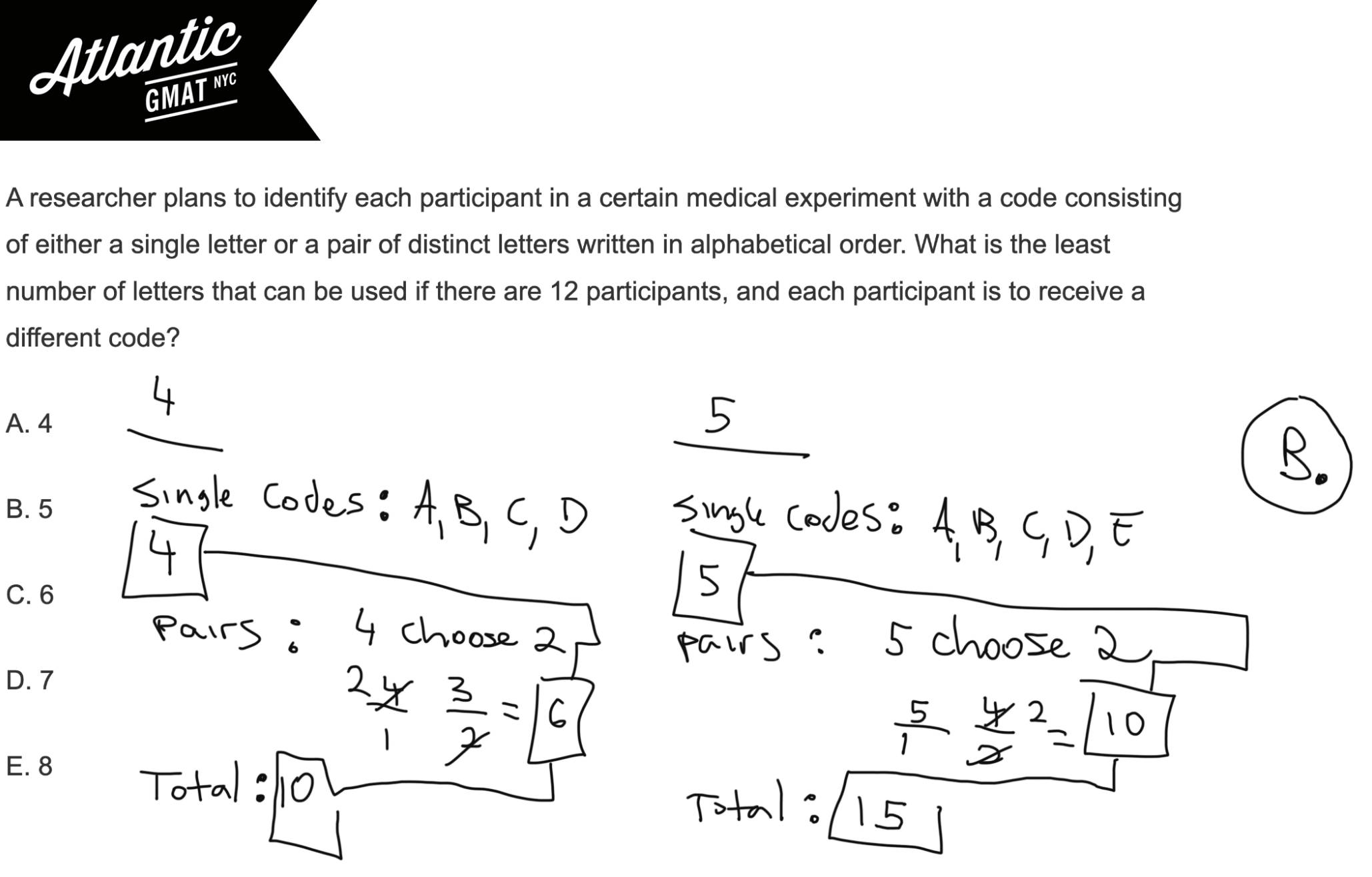A researcher plans to identify each participant in a certain medical experiment with a code consisting of either a single letter or a pair of distinct letters written in alphabetical order. What is the least number of letters that can be used if there are 12 participants, and each participant is to receive a different code?
A. 4
B. 5
C. 6
D. 7
E. 8
We need to help this researcher identify 12 participants using single letters or pairs of letters in alphabetical order. Key info: we want the LEAST number of letters to make these 12 codes. The word code should trigger: ordering! Yes, codes usually involve an ordering element. However, not always and this is one of the exceptions. Whenever a code has to be in alphabetical order or ascending/descending order it is highly likely that it no longer has an ordering element and should be treated as a group.
So what does that mean for our researcher and his medial experiment? Well, let’s start testing the answers to find the least value that can create 12 codes. With that in mind start with the smallest number. Why? Because if the smallest number works then it’s the correct answer. If say, 6 works, then you still need to test 5 and potentially 4. If looking for a max you might start with the biggest answer choice.
Ok, so how do we test 4? Well, you have 4 single digit codes say A, B, C, D.
But how about the pairs? Again, think of this as a group. So it’s a group of 2 with 4 choices. Or 4 choose 2.
4*3/1*2 = 6
So 4 (single) + 6 (pairs) = 10.
Not enough to identify our twelve participants!
Let’s try 5.
A, B, C, D, E
5 single codes.
5*4/1*2 = 10
10 pairs
10 + 5 = 15. That works!
So the least number of letters needed to identify the 12 participants: 5. B.
That’s one way to do it. There’s also a very practical way to approach this combinatorics puzzle. And, all over the GMAT, especially on combinatorics questions with a very limited numbers of possibilities (we’re only looking for 12 codes here) remember to stay down to earth. Sometimes you can just make a list. And sometimes that will be the fastest approach. Again: stay practical on the GMAT!
So let’s try 4 letters.
Single Letter Codes: 4
A, B, C, D
Pairs: 6
AB. BC. DE
AC. BD
AD
Total Codes: 10
Let’s try 5 letters.
Single Letter Codes: 5
A, B, C, D, E
Pairs: 10
AB BC. CD. DE
AC. BD. CE
AD. BE
AE
Total Codes: 15
If you’re taking a practical approach take your time planning. Think about how you want to make your list. Don’t rush it. What I see a lot in GMAT tutoring is students having a decent understanding of how to approach things from a practical perspective BUT because they’re not using a formula or test prep technique don’t feel confident and then rush the setup/execution. Then they get the feeling that the practical approach doesn’t work and that they need a formula for everything. So, again, if you’re going for a non-formulaic setup, which sometimes is exactly what you should do, give it the space to succeed.
Video Solution: A researcher plans to identify each participant in a certain medical experiment with a code consisting of either a single letter or a pair of distinct letters written in alphabetical order. What is the least number of letters that can be used if there are 12 participants, and each participant is to receive a different code?
Additional GMAT Combinatorics Practice Question Examples
Here is a grouping question from the GMAT Prep Tests. This is using the same method of grouping as the question above (although it has different conditions/constraints).
Another grouping question but this time Data Sufficiency from GMAT Question of the Day
Here is a somewhat standard GMAT Combinatorics Code example from GMAT Question of the Day
Finally another wordy combinatorics example from question of the day


